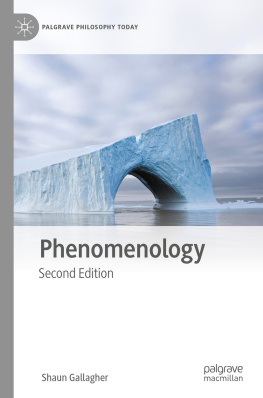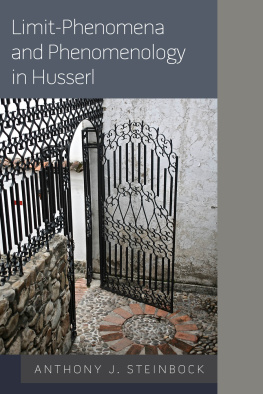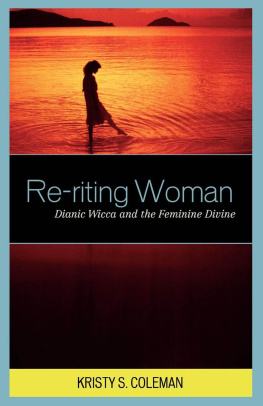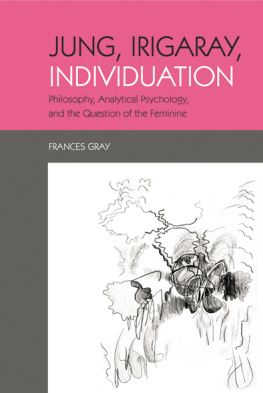Published by State University of New York Press, Albany
2014 State University of New York
All rights reserved
Printed in the United States of America
No part of this book may be used or reproduced in any manner whatsoever without written permission. No part of this book may be stored in a retrieval system or transmitted in any form or by any means including electronic, electrostatic, magnetic tape, mechanical, photocopying, recording, or otherwise without the prior permission in writing of the publisher.
For information, contact State University of New York Press, Albany, NY
www.sunypress.edu
Production by Eileen Nizer
Marketing by Michael Campochiaro
Library of Congress Cataloging-in-Publication Data
Lehtinen, Virpi, 1970
Luce Irigaray's phenomenology of feminine being / Virpi Lehtinen.
pages cm. (SUNY series in gender theory)
Includes bibliographical references and index.
ISBN 978-1-4384-5127-5 (hardcover : alk. paper)
1. Irigaray, Luce. I. Title.
B2430.I74L44 2014
155.3'33dc23
2013021966
10 9 8 7 6 5 4 3 2 1
I dedicate this book to the memories of my grandmothers
Aili Flinkman and Siiri Lehtinen; to my mother Terttu;
and to my daughter Tuuli-Titania.Preface
At its most promising, Luce Irigarays work is an exemplification and catalyst of the dynamic forces of change and transformation. From the perspective of phenomenology of the body, persons and their works such as (philosophical) writings constitute a complex network of dynamic relations and are constituted by such relations. These include relations to oneself or to itself, to other persons or writings, and to the world, all formed in embodied, affective, and spiritual dimensions of subjectivity. In our written works these constitutive relations can be made explicit and elaborate or they can remain implicit, even hidden. Similarly, these constitutive processes, with their inherent dynamism and potentiality for truthfulness, can be recognized, cultivated, and developed to varying degrees in our individual and communal lives. On the basis of these ideas, this book maintains that change and transformation are inherently anchored in Irigarays philosophy in its focus on these constitutive relations and their inherent dynamism with regards to topics, themes, style, and potentiality for truthfulness. The aim is to provide means for perceiving Irigaray as a radical philosopher of change and transformation in the following six respects.
Irigarays work offers both the impulse and means for personal growth and flourishing. Irigarays work demonstrates that the perspectives of women have not been traditionally included to the philosophical investigations of the sense of being, and the lives of women have thus not gained elaborate and self-defined expression in the spiritual sphere of being. In response to this, Irigarays work is consciously written from the first-person perspective of a woman. In so doing, she invites the reader to more fully assume her/his own first-person perspective in reading, speaking, writing, and acting, i.e., to participate more fully in the process of the constitution of the sense of human existence. This process entails the observation of the continuities and discontinuities between ones own experience, Irigarays first-person expressions with reference to feminine pre-discursive experience, and the relation of both to the general structures of experience. Moreover, Irigarays opaque way of writing invites us to continue completing, questioning, and offering alternative ways of manifesting and acknowledging feminine being, be it in thinking and writing or in acting and living. On the basis of these observations I suggest that Irigarays work exemplifies feminine being in its bodily and spiritual generative potentiality by opening up the possibility of an infinite process of differentiation.
This work presents Irigaray as a philosopher of love and desire par excellence. In Irigarays daimonic conception of eros, desire and love are understood as the most intense transformative forces in human life. Love and desire are oriented toward future, which is opened up in the way we inhabit the here-and-now of our becoming. In their intensity, love and desire reveal the affective element inherent in our perception and in our attitudes toward ourselves, others, and the world. Moreover, detached from the metaphysical presupposition of the hierarchical dichotomy of the soul and the body, love and desire appear as permeating all the dimensions of subjectembodiment, affectivity, and spirituality. Understood in these ways, love and desire are prone to open us not only more fully to the actual but also to the potential in our relations to ourselves, to others, and to the world.
3. Philosophical discourse and practice can become more truthful in its investigations of being and the sense of human existence if the first-person perspectives and expressive acts of women are included. At its best, philosophical thought that has culminated in speeches and writings can exemplify the generativity inherent in love and desire. Irigarays work shows how we, by returning to the daimonic origins of eros through sexual difference, can become conscious of and more fully realize the philosophical practice as thinking, speaking, and writing as gendered human beings who are both incarnate and spiritual. Irigarays own work, in its materiality, affectivity, and spirituality, is exemplary here, but she also detects such potentiality in the classical philosophical works. Her works address the reader as a woman and a philosopher with no contradiction between the two, in contrast to the philosophical culture in general. In this way, her work also establishes a model of a woman-woman relation (in philosophy). Irigarays philosophical work also demonstrates that any philosopher is necessarily connected to the other spheres of life, and all dimensions of subjectivity, even when these relations remain unrecognized.
Irigarays work provides means to become conscious of our habitual ways of living and thinking gendered being. As such her work contributes to renewing, developing, and cultivating these ways and becoming better aware of them with both their restrictions and potentialities. An example is Irigarays explanation of how the sense of woman and femininity has been traditionally male-defined, and she also shows that the effort of forming the self-defined feminine being, each doing her own part, is still needed and meaningful. This task of rethinking femininity and masculinity is in principle unaccomplishable, and is significant also in respect to reconceptualizing gender-blending identities. This is because gender-blending identities are more often than not articulated as a variety of relations to masculinity and femininity; also from this perspective, masculinity and femininity seem to constitute the sense-forming basis of gendered being in its variety. The sense of femininity and masculinity, however, can be conceptualized and lived as open to differences or with a tendency toward similarity, and herein lies the decisive point of the actualization of sexual difference/indifference or sameness, as Irigarays work urges us to recognize.










